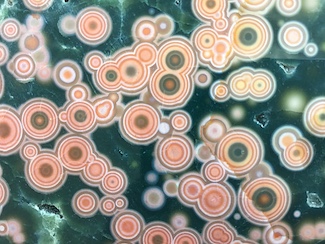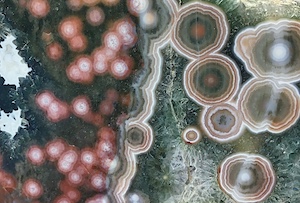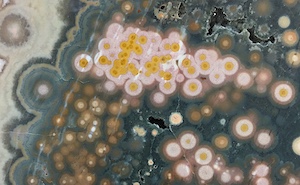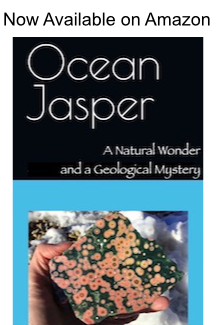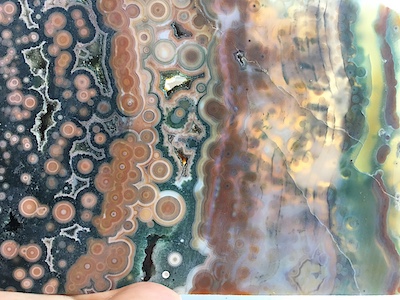Research Content Page
*Order the New Book: "Ocean Jasper: A Natural Wonder and a Geological Mystery"
Book Contents (Copyright 2019, © Susanne Lomatch, published on Amazon):
-Part I Introduction: Ocean Jasper: Why We Need To Preserve It
-Part II Theory of Formation, 2019: Ocean Jasper (Spherulitic Chalcedony) of Madagascar: Model/Theory of Formation
*Translation of Lieber, 2003: Spharolithischer Chalcedon von Madagaskar, W. Lieber, Lapis 2003 (Translation)-Part I Introduction: Ocean Jasper: Why We Need To Preserve It
-Part II Theory of Formation, 2019: Ocean Jasper (Spherulitic Chalcedony) of Madagascar: Model/Theory of Formation
*Interpretive Specimen Guide, 2021
Photos from the translator's collection that closely match those shown in Lieber's 2003 article, with explanation and discussion. Readers should note that
all of the specimens shown in Lieber's original work (10 figures, 14 photos) were mined 2003 and earlier, and contain many of the archetypes of Ocean Jasper that have been
identified from later mined deposits. "Old stock" Ocean Jasper is commonly recognized by the collector community as all of the material mined from 1999-2006, from both Marovato
(off shore) and Kabamby (inland) deposits. Since no cataloguing was kept on what variety was mined when and where (other than obvious varieties such as the highly recognized Kabamby type),
researchers and collectors must make estimates of mining date, deposit/location, etc. Mapping specimen pieces together has been one valuable tool for this effort, as has been identifying
original sale and/or photo dates of rough and polished specimens. It is not known whether there were more than two "localized" deposits of off-shore collection sites. This researcher believes that
there may have been more than the identified two large deposits that produced the bulk of the material mined between 1999-2006 from Marovato, as there are isolated cases of specimens
collected much earlier, dating back to the 1960s. Lieber's specimens are not labeled according
to mining location, and contain specimens similar to both Marovato and Kabamby type. "Old stock" Marovato material was tapped out in 2006. There have been several "new finds" since,
between 2013-2019, all reportedly further inland. Kabamby material is primarily a "surface" collection over a wide inland area and is still collected today. This Specimen Gallery serves
as a resource to other researchers and collectors on "early" collection material, as well as the special features of this amazingly complex wonder.
*Pattern Formation in Ocean JasperA short description of the dynamics involved in producing the myriad of patterns in Ocean Jasper.
*Spherulite Tails in Ocean JasperWhy do spherulite tails occur in Ocean Jasper? A Tale of a Whale's Tail.
*Zoning and Spherulite Banding in Ocean JasperAn in-depth explanation of these phenomena.
*Questions and Answers on Ocean Jasper, 2022
Answers to questions I've received from curious minds, mostly about formation theory.
*Color in Ocean Jasper
Additional explanations regarding color and pronounced color zoning.
*New Research, 2020: Characterization Studies of Ocean Jasper Research Content:
I have translated Werner Lieber's seminal 2003 article in Lapis from German to English.
Figures can be found in the original Lapis article, only the text is translated. I have recently added photos from my own collection that are similar to
Lieber's original photos (copyright protected). This Interpretive Specimen Guide, 2021 has extensive analysis and commentary and is worth a visit.
New comprehensive research (2003-2019) and review work from my hand has now been published in a book available in either eBook or Paperback format, on Amazon, and iBook from Apple Books, the first book published on Ocean Jasper. All sale proceeds are donated to ongoing and future research studies, particularly toward the costs of expensive lab testing.
New petrological research results are now available, see Mindat link above. This is Part I of a multi-part study, Part II will include the results and analysis from other testing modalities. The new and "next-step" work involves 16 samples from 7 specimens. Cost of Part I studies reported above was $653; estimated cost of Part II studies is at least $2500. If you'd like to support these expensive studies, buy the book, all net author proceeds are donated to these studies!
New comprehensive research (2003-2019) and review work from my hand has now been published in a book available in either eBook or Paperback format, on Amazon, and iBook from Apple Books, the first book published on Ocean Jasper. All sale proceeds are donated to ongoing and future research studies, particularly toward the costs of expensive lab testing.
New petrological research results are now available, see Mindat link above. This is Part I of a multi-part study, Part II will include the results and analysis from other testing modalities. The new and "next-step" work involves 16 samples from 7 specimens. Cost of Part I studies reported above was $653; estimated cost of Part II studies is at least $2500. If you'd like to support these expensive studies, buy the book, all net author proceeds are donated to these studies!
